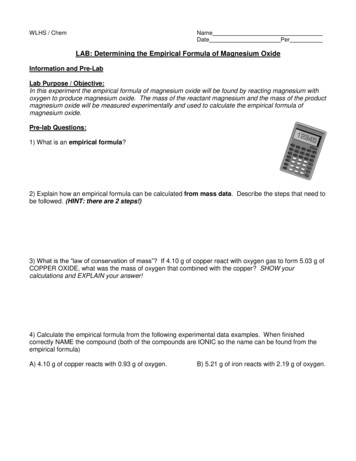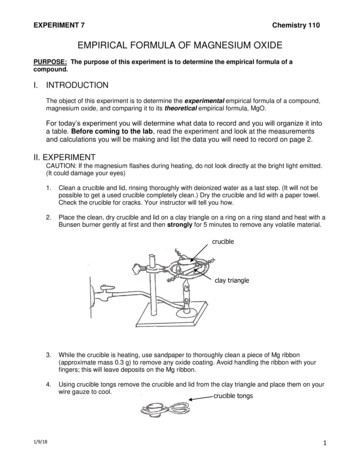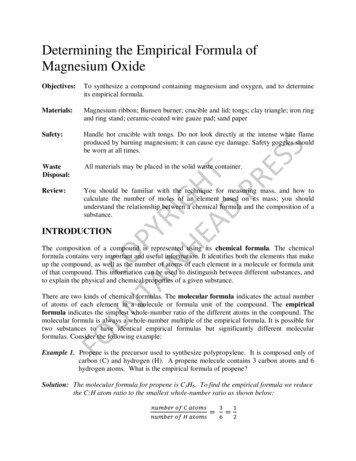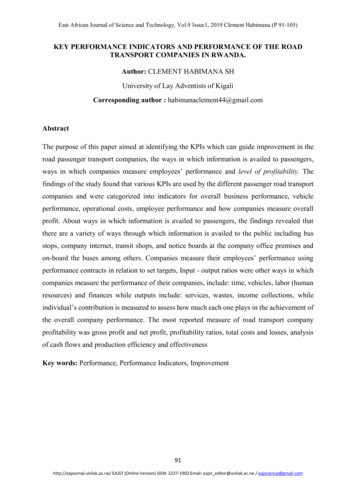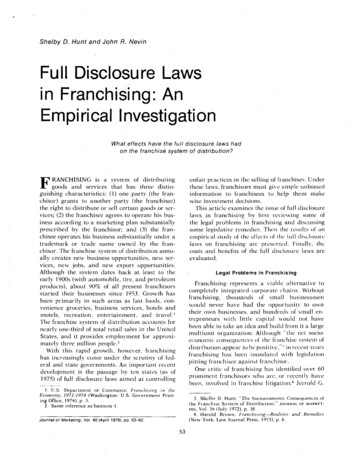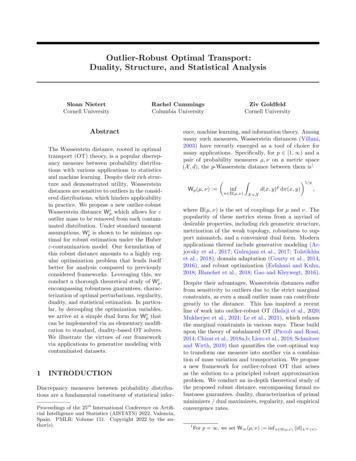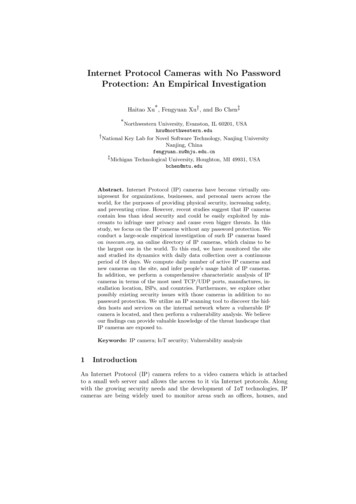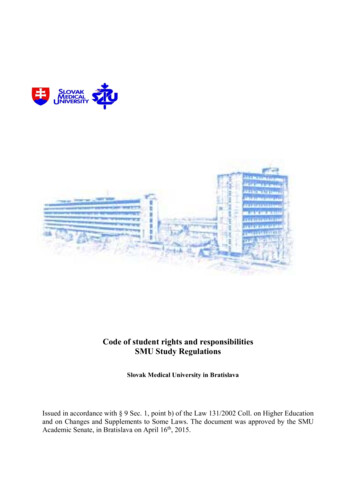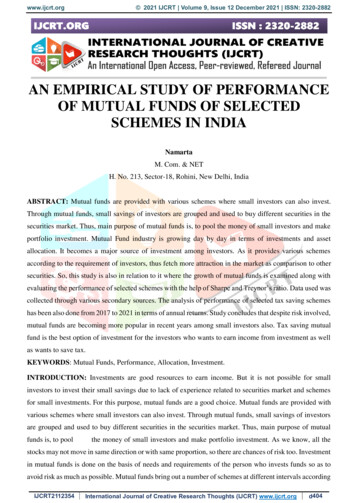
Transcription
www.ijcrt.org 2021 IJCRT Volume 9, Issue 12 December 2021 ISSN: 2320-2882AN EMPIRICAL STUDY OF PERFORMANCEOF MUTUAL FUNDS OF SELECTEDSCHEMES IN INDIANamartaM. Com. & NETH. No. 213, Sector-18, Rohini, New Delhi, IndiaABSTRACT: Mutual funds are provided with various schemes where small investors can also invest.Through mutual funds, small savings of investors are grouped and used to buy different securities in thesecurities market. Thus, main purpose of mutual funds is, to pool the money of small investors and makeportfolio investment. Mutual Fund industry is growing day by day in terms of investments and assetallocation. It becomes a major source of investment among investors. As it provides various schemesaccording to the requirement of investors, thus fetch more attraction in the market as comparison to othersecurities. So, this study is also in relation to it where the growth of mutual funds is examined along withevaluating the performance of selected schemes with the help of Sharpe and Treynor’s ratio. Data used wascollected through various secondary sources. The analysis of performance of selected tax saving schemeshas been also done from 2017 to 2021 in terms of annual returns. Study concludes that despite risk involved,mutual funds are becoming more popular in recent years among small investors also. Tax saving mutualfund is the best option of investment for the investors who wants to earn income from investment as wellas wants to save tax.KEYWORDS: Mutual Funds, Performance, Allocation, Investment.INTRODUCTION: Investments are good resources to earn income. But it is not possible for smallinvestors to invest their small savings due to lack of experience related to securities market and schemesfor small investments. For this purpose, mutual funds are a good choice. Mutual funds are provided withvarious schemes where small investors can also invest. Through mutual funds, small savings of investorsare grouped and used to buy different securities in the securities market. Thus, main purpose of mutualfunds is, to poolthe money of small investors and make portfolio investment. As we know, all thestocks may not move in same direction or with same proportion, so there are chances of risk too. Investmentin mutual funds is done on the basis of needs and requirements of the person who invests funds so as toavoid risk as much as possible. Mutual funds bring out a number of schemes at different intervals accordingIJCRT2112354International Journal of Creative Research Thoughts (IJCRT) www.ijcrt.orgd404
www.ijcrt.org 2021 IJCRT Volume 9, Issue 12 December 2021 ISSN: 2320-2882to various investment objectives so as to cover all kinds of investors. These objectives may be related toregular income or growth of funds, with lower or higher risk or related to tax savings. Therefore, it isbeneficial to invest through mutual funds as it gives the advantages of professional management of fund,diversity, suitability, risk avoidance, fluidity and many more. Mutual funds are registered under Securitiesand Exchange Board of Indian (SEBI) thus makes investment in mutual funds an effortless, approachableand affordable process.TYPES OF MUTUAL FUNDS:There are various kinds of mutual fund schemes launched by mutual fund institutions from time to timeaccording to the demands of investors so as to fulfill their objectives. The different types of schemes undervarious categories and sub-categories are given as:I. On the basis of Right of Possession: In this category the mutual fund schemes are dividedaccording to their ownership i.e. public and private sector mutual funds.1. Public Sector Mutual Funds: These are funds which are controlled by Government or which comeunder the control of Government. As already discussed, UTI was first to enter in mutual fundsbusiness in 1963-64 and had monopoly in the market. After that a number of public sector banksand institutions started involving in mutual funds. It include State bank of India, Indian bank,Canara bank, Punjab National Bank and insurance institutes as GIC and LIC.2. Private Sector Mutual Funds: The success and growth of mutual funds led the Government ofIndia to allow private sector to start business of mutual funds. A number of private corporateapproached SEBI for this. This brought the era of competition among private and public playerswhich led to the positive growth of mutual funds industry.II. On the basis of Working of Schemes: All the mutual funds fall under this category of schemes.According to working of schemes, mutual funds can be divided into three sub-categories:1. Open Ended Schemes\Funds: This scheme of mutual funds does not specify any duration ortiming of investing and redemption. It means these have no fixed date of maturity as well asinvestment in schemes. The investor has, thus, the option to invest in such schemes at any point oftime. Basically, repurchase/ redemption of such funds is done on the basis of net asset value (NAV)of fund.2. Closed Ended Funds: It is a scheme, unlike open ended scheme, where there is fixed period ofentry into fund and similarly, for its maturity. Once the initial issue is closed, there is no otheroption then for subscribing the units for sale or purchase through secondary market. The price hereis determined according to demand and supply in the market and can be different from net assetsvalue i.e. .NAV.IJCRT2112354International Journal of Creative Research Thoughts (IJCRT) www.ijcrt.orgd405
www.ijcrt.org 2021 IJCRT Volume 9, Issue 12 December 2021 ISSN: 2320-28823. Interval Schemes: This scheme is the mixture of both open ended and close ended schemes. Underthis, the scheme is kept open for sometimes and then runs as closed ended scheme. When a newscheme is launched, it remains as open ended for sometimes and then converted into closed endedscheme. Thus, the value of fund is calculated accordingly.III. On the basis of Investment Objectives: Under this category, the investment goals of investors areconsidered and sub-categorized as:1. Income Funds: The aim under this scheme is to maximize the current income to the investor. Here,capital appreciation is of less importance and preference is given to regular returns. The return canbe constant at low level of risk and increases as the risk increases.2. Equity Funds: These are also known as growth funds. The principle objective of these funds is toprovide growth in the value of invested money in long run. Thus the risk content is also higher.3. Conservative Funds: This scheme is the mixture of both income and growth fund schemes. In this,some amount of funds is invested in buying interest bearing securities and other part in equity forlong term value appreciation.4. Taxation Funds: There are some schemes of mutual funds in the market which are designed fortax payers. It gives tax benefits to the investors along with some income. ELSS is such a kind ofscheme which is famous among investors who want to avoid the tax burden and claim deductionunder section 80C.5. Other Schemes: Mutual funds can be large caps, medium cap and small cap on the basis of marketcapitalization and can be domestic funds or offshore funds on the basis of location from wherefunds are mobilized.OBJECTIVES OF STUDY:1. To examine the growth of mutual funds in India.2. To examine the performance of selected tax saving mutual fund schemes in comparison tobenchmark.3. To evaluate the performance of selected schemes with the help of Sharpe and Treynor’s ratio.RESEARCH METHODOLOGY:The study is wholly based on secondary data. The data related to study has been collected from om and other websites related to mutual funds are also used for the purpose of study.Website of SEBI is used to investigate the growth of mutual funds. Similarly, websites related to particularfund has been used to collect data for evaluating performance in comparison to benchmark for the periodof 2017 to 2021.IJCRT2112354International Journal of Creative Research Thoughts (IJCRT) www.ijcrt.orgd406
www.ijcrt.org 2021 IJCRT Volume 9, Issue 12 December 2021 ISSN: 2320-2882SAMPLING:Five tax saving mutual fund schemes has been selected on the basis of CRISIL ranking. The selectedschemes are given as:1. Axis Long Term Equity Regular Plan(G)2. Aditya Birla SL Tax Relief 96(G)3. Canara Robeco Equity Saver- Regular(G)4. Taurus Tax Shield(G)5. ICICI Prudential LT Equity(Tax Saving)(G)GROWTH OF MUTUAL FUNDSAccording to market schemes: On 01 December, 2017, total number of schemes was1861. Among this,number of schemes under income funds were 1353, 408 under growth schemes, 25 under balanced fundsand 45 under exchange traded funds. Schemes under funds of fund investing overseas were 30. On 01December, 2021, the total number of schemes were 1941 and out of which, 1263 were under income fundswhich includes money market schemes, gilt edged securities, debt securities and investments ininfrastructural development. There were 548 schemes under growth funds and 26 under balanced funds.The number of schemes under exchange traded funds stood at 75 and 29 under funds of fund investingoverseas.Table 1.1: Category wise no. of schemesCategory20172021Income Scheme13531263Growth Schemes408548Balanced schemes2526ETF4575Fund of Funds investing overseas3029Total18611941Fund mobilization : The funds mobilized under various schemes are given as on 01 December, 2017, Thegrand total of funds mobilized were Rs.81, 94,887.09 crores. The grand total of funds mobilized in the year2021 on 01 December were Rs. 1, 79, 13,671.28 crores.Category20172021Income Scheme80, 73,124.101, 75, 78,230.95Growth Schemes1, 05,460.092, 32,319.52Balanced schemes9, 191.0842, 640.24ETF6, 587.8460, 028.76Fund of Funds investing overseas523.99488.30Total81, 94,887.091, 79, 13,671.28IJCRT2112354International Journal of Creative Research Thoughts (IJCRT) www.ijcrt.orgd407
www.ijcrt.org 2021 IJCRT Volume 9, Issue 12 December 2021 ISSN: 2320-2882COMPARISON OF SCHEMES WITH BENCHMARK:The comparison of all five schemes with the benchmark is done on the basis of returns of last five years.For this purpose, NIFTY 50 is taken as benchmark index. The values of annual returns will be comparedfor evaluating performance of schemes as compare to overall market.YearNiftyAxis LongAdityaCRTaurusICICI Pru50TermBirlaEquityTaxLT EquityEquitytax 20213.492.14-4.982.29-0.76-0.29EVALUATION OF PERFORMANCE WITH THE HELP OF SHARPE RATIO ANDTREYNOR’S RATIO:Scheme wise comparison shows that Axis LT Equity Regular Plan (G) has highest value of standarddeviation (13.52) and beta (0.97) as compare to other schemes, whereas ICICI Prudential LT Equity (TaxSaving ) –G has the lowest values of standard deviation and beta. This shows that the former schemeinvolves more risk as compare to all other schemes.However, CR Equity Saver-Regular (G) has shown highest performance in terms of Sharpe (0.92) andTreynor (0.21) ratio. This is followed by Aditya Birla SL Tax Relief 96(G) andTaurus Tax Shield. On the other hand, Axis LT Equity Regular Plan (G) has the lowest values of Sharperatio (0.61) as well as Treynor ratio (0.08) showing poor performance when compared with risk involvedin various schemes.SchemeStd. DeviationBetaSharpe RatioTreynor’s Ratio13.520.970.610.0812.830.900.890.17CR Equity Saver12.560.940.920.21Taurus Tax TEquityRegular PlanAditya Birla SLtax reliefPruLTEquity SavingIJCRT2112354International Journal of Creative Research Thoughts (IJCRT) www.ijcrt.orgd408
www.ijcrt.org 2021 IJCRT Volume 9, Issue 12 December 2021 ISSN: 2320-2882FINDINGS: The mutual fund industry shows a tremendous growth in recent years. Number of schemes hasincreased from 1861 to 1941 from the year ending 2017 to 2021. The number of open endedschemes increased from 798 to 860; closed ended schemes from 987 to 1054 whereas intervalschemes decreased from 76 to 27 during this period. The industry also shows increase growth in terms of mobilization of funds. Fund mobilization underincome scheme increased from Rs. 80, 35,320.76 crores to Rs. 1, 75, 78,230.95 and it was increasedto Rs. 2, 32,319.52 and Rs. 42,604.24 in case of growth oriented and balanced schemesrespectively. When compared to benchmark NIFTY50 in terms of annual returns, scheme 4 Taurus Tax Shieldoutperformed benchmark in every year from 2017 to 2021. In terms of Sharpe and Treynor’s ratios, scheme 3 i.e. CR Equity Saver-Regular (G) shows betterrisk-return adjustment ratio of 0.92 and 0.21 respectively, in comparison to other schemes.CONCLUSION:During the period of study (from 2017 to 2021), tremendous growth has been witnessed in Mutual FundIndustry in India. It shows rising trend in terms of number of schemes, fund mobilization and assets undermanagement. With the increasing number of players both from public and private sectors, competition isalso increasing which may lead to positive growth in this industry. In recent years, private sector isoverlapping public sector as wide variety of schemes are launched by private sector according to therequirement of various classes of investors. Mutual funds are becoming popular due to increase in level ofincome which will ultimately increase the taxes. To decrease the burden of tax and enhance savings,Government comes up with tax saving schemes and provides deductions on the income from such schemesalso. The analysis of performance of selected tax saving schemes has been also done from 2017 to 2021 interms of annual returns. To analyze the risk-return relationship tools like standard deviation, beta, Sharperatio and Treynor’s ratio has been used. Further, the performance of schemes is also evaluated ascomparison to benchmark.As per ranking, Aditya Birla SL Tax Relief-Regular (G) tops the list in combination of all the measures ofevaluating performance and it was followed by Taurus Tax Shield, Axis LT Equity-Regular(G), CR EquitySaver-Regular(G) and ICICI Prudential LT Equity (Tax Saving)-G in order. To summarize, it can be saidthat despite risk involved, mutual funds are becoming more popular in recent years among small investorsalso. Tax saving mutual fund is the best option of investment for the investors who wants to earn incomefrom investment as well as wants to save tax.IJCRT2112354International Journal of Creative Research Thoughts (IJCRT) www.ijcrt.orgd409
www.ijcrt.org 2021 IJCRT Volume 9, Issue 12 December 2021 ISSN: 2320-2882REFERENCES:1. Athma, P., and Kumar, K.R. (2011). ETF vis-à-vis Index Funds: an Evaluation. Asia Pacific Journalof Research in Business Management, 2(1), 188-205.2. Bodla, B.S., and Garg, A. (2007). Performance of Mutual Funds in India: Empirical Study ofGrowth Schemes. GITAM Journal of Management, 29-43.3. Chander, R. (2000). Performance Appraisal of Mutual Funds in India. Finance India, XIV (4), 12561261.4. Das, S. (2013). A Study on the Performance of Select Open-Ended Diversified Equity Funds inIndia. Research Bulletin, The Institute of Cost Accountants of India, 47-62.5. Gupta, A. (2001). Mutual Funds in India: A Study of Investment Management. Finance India, XV(2), 631-37.6. Pasricha, J, S. (1996). Mutual Funds in India: Performance and Prospects. In Bhatia, B.S and Batra,G.S edited “Management of Financial Services”. New Delhi: Deep and Deep Publications.7. Sharath, J. (2004). Evaluating Indian Mutual Funds. Chartered Financial Analyst, p83.8. Swaaminathan, T.M. (2011). Performance of Mutual Funds in India: A Comparative Study ofPublic and Private Sector Mutual Funds. New Delhi: Gyan Publishing House.9. Turan, M.S., Bodla, B.S., and Mehta, S.K. (2001). Performance Evaluation of Listed Schemes ofMutual Funds. Management Researcher, VIII (1 & 2), 38-66.10. www.sebi.gov.in11. www.amfiindia.com12. www.moneycontrol.com13. www.valueresearchonline.com14. www.axismf.com15. l Journal of Creative Research Thoughts (IJCRT) www.ijcrt.orgd410
which led to the positive growth of mutual funds industry. II. On the basis of Working of Schemes: All the mutual funds fall under this category of schemes. According to working of schemes, mutual funds can be divided into three sub-categories:- 1. Open Ended Schemes\Funds: This scheme of mutual funds does not specify any duration or
